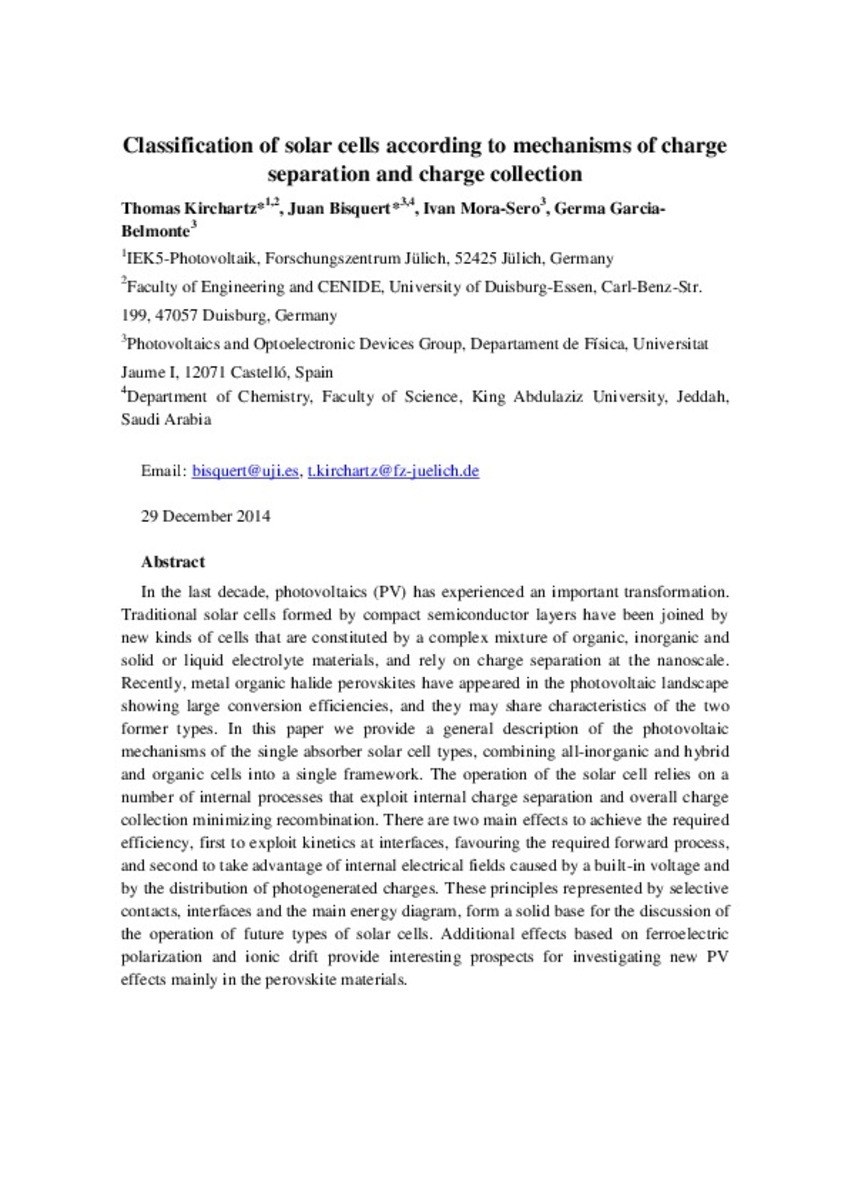Mostrar el registro sencillo del ítem
Classification of solar cells according to mechanisms of charge separation and charge collection
| dc.contributor.author | Kirchartz, Thomas | |
| dc.contributor.author | Bisquert, Juan | |
| dc.contributor.author | Mora-Sero, Ivan | |
| dc.contributor.author | Garcia-Belmonte, Germà | |
| dc.date.accessioned | 2016-03-23T18:50:39Z | |
| dc.date.available | 2016-03-23T18:50:39Z | |
| dc.date.issued | 2015 | |
| dc.identifier.issn | 1463-9076 | |
| dc.identifier.issn | 1463-9084 | |
| dc.identifier.uri | http://hdl.handle.net/10234/155245 | |
| dc.description.abstract | In the last decade, photovoltaics (PV) has experienced an important transformation. Traditional solar cells formed by compact semiconductor layers have been joined by new kinds of cells that are constituted by a complex mixture of organic, inorganic and solid or liquid electrolyte materials, and rely on charge separation at the nanoscale. Recently, metal organic halide perovskites have appeared in the photovoltaic landscape showing large conversion efficiencies, and they may share characteristics of the two former types. In this paper we provide a general description of the photovoltaic mechanisms of the single absorber solar cell types, combining all-inorganic and hybrid and organic cells into a single framework. The operation of the solar cell relies on a number of internal processes that exploit internal charge separation and overall charge collection minimizing recombination. There are two main effects to achieve the required efficiency, first to exploit kinetics at interfaces, favouring the required forward process, and second to take advantage of internal electrical fields caused by a built-in voltage and by the distribution of photogenerated charges. These principles represented by selective contacts, interfaces and the main energy diagram, form a solid base for the discussion of the operation of future types of solar cells. Additional effects based on ferroelectric polarization and ionic drift provide interesting prospects for investigating new PV effects mainly in the perovskite materials. | ca_CA |
| dc.description.sponsorShip | This work was supported by MINECO of Spain under a project (MAT2013-47192-C3-1-R), and the Helmholtz-Energy-Alliance ‘‘Hybrid-Photovoltaics’’. | ca_CA |
| dc.format.extent | 21 p. | ca_CA |
| dc.format.mimetype | application/pdf | ca_CA |
| dc.language.iso | eng | ca_CA |
| dc.publisher | Royal Society of Chemistry | ca_CA |
| dc.relation.isPartOf | Phys. Chem. Chem. Phys., 2015, 17, 4007 | ca_CA |
| dc.rights | This journal is © the Owner Societies 2015 | ca_CA |
| dc.rights.uri | http://rightsstatements.org/vocab/InC/1.0/ | * |
| dc.subject | halide perovskite | ca_CA |
| dc.subject | electron injection | ca_CA |
| dc.subject | space-charge | ca_CA |
| dc.subject | devices | ca_CA |
| dc.subject | energy | ca_CA |
| dc.subject | performance | ca_CA |
| dc.subject | interface | ca_CA |
| dc.subject | recombination | ca_CA |
| dc.subject | deposition | ca_CA |
| dc.subject | conversion | ca_CA |
| dc.title | Classification of solar cells according to mechanisms of charge separation and charge collection | ca_CA |
| dc.type | info:eu-repo/semantics/article | ca_CA |
| dc.identifier.doi | http://dx.doi.org/10.1039/c4cp05174b | |
| dc.rights.accessRights | info:eu-repo/semantics/openAccess | ca_CA |
| dc.relation.publisherVersion | http://pubs.rsc.org/en/content/articlepdf/2015/cp/c4cp05174b | ca_CA |
| dc.type.version | info:eu-repo/semantics/submittedVersion |
Ficheros en el ítem
Este ítem aparece en la(s) siguiente(s) colección(ones)
-
FCA_Articles [508]
Articles de publicacions periódiques







